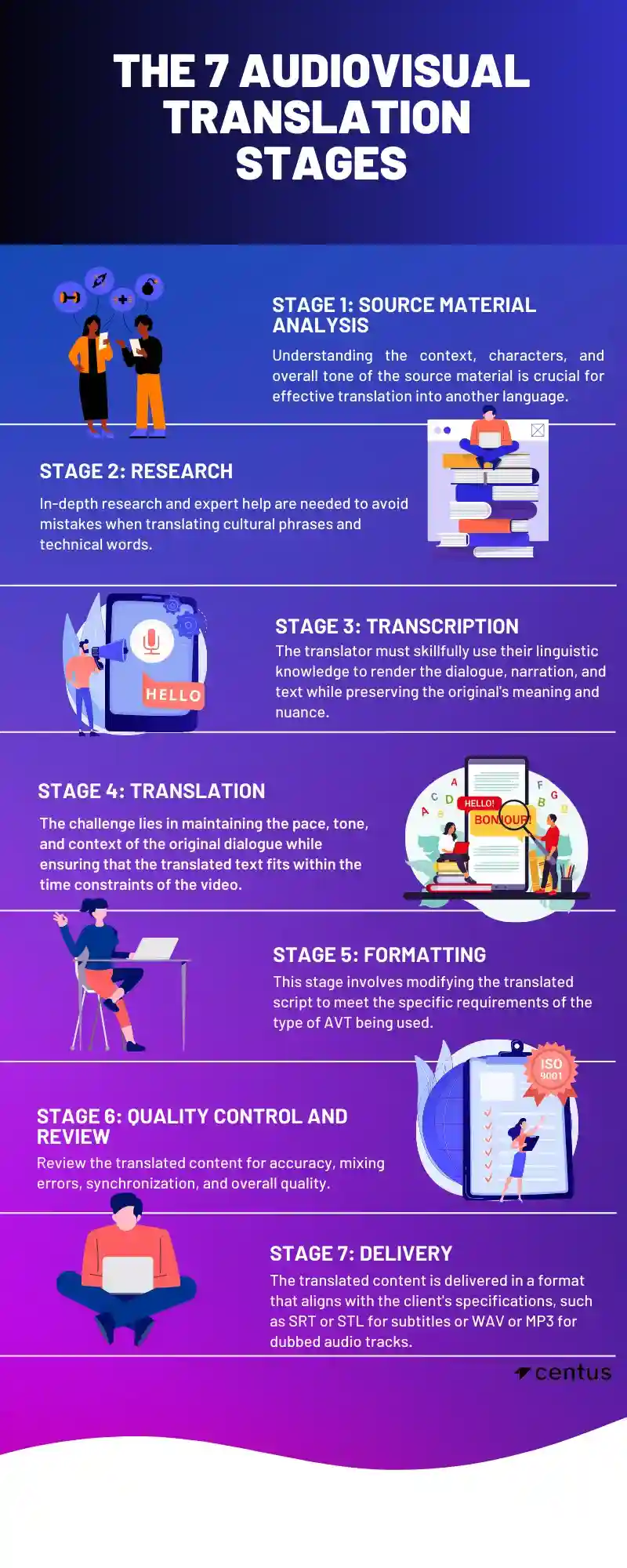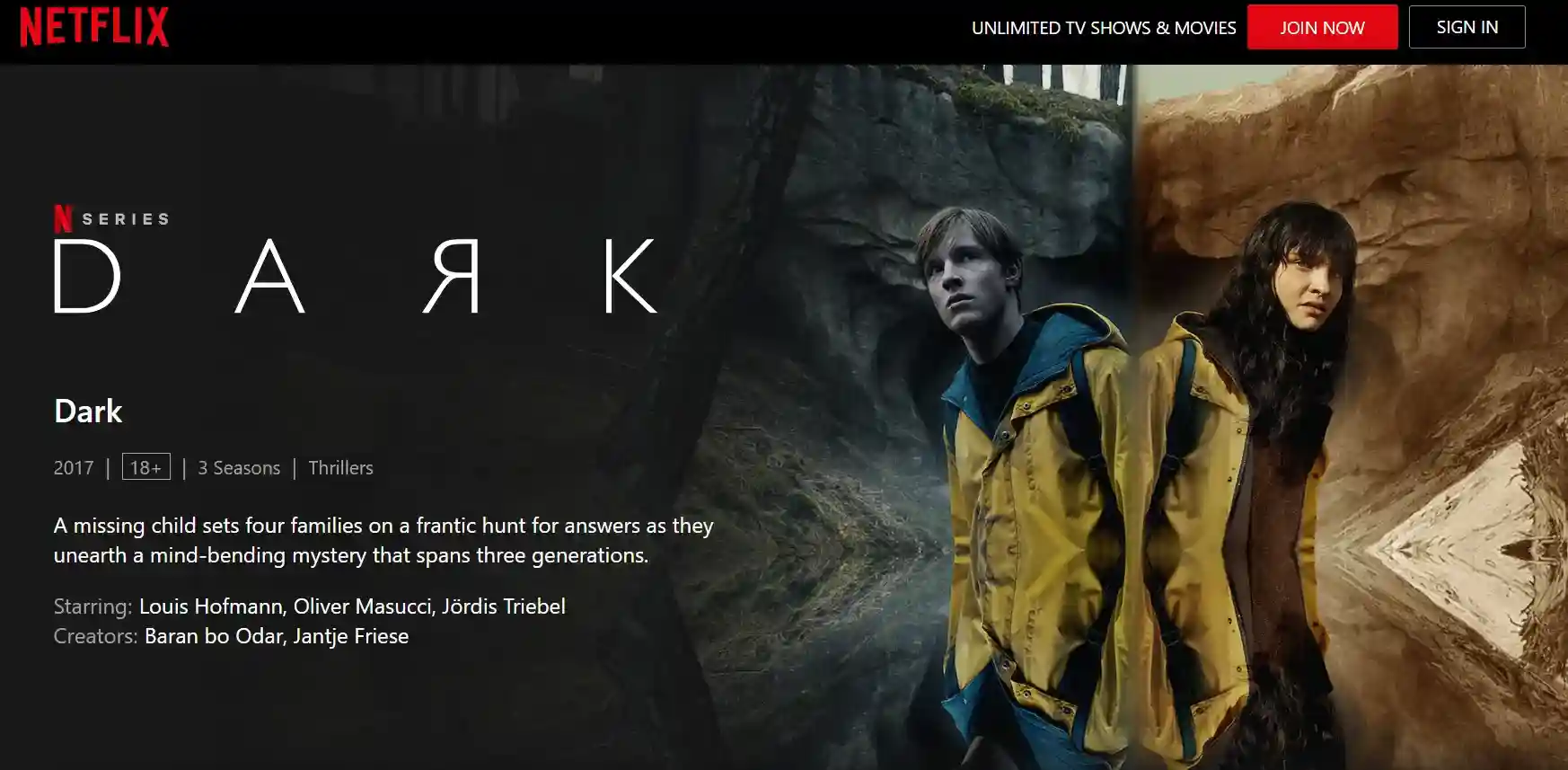What Is Audiovisual Translation and How Is It Done?
In an age where content knows no borders, audiovisual translation (AVT) brings cultures and languages together.
AVT is key in today’s global world, so people from different cultures and backgrounds can access the same media. But what is audiovisual translation and how does it work?
In this post we will look at the different types of AVT, the challenges of being an AVT professional and the benefits of working with an experienced AVT partner.
Pro tip: Use a professional AVT management system like Centus to streamline your audiovisual translation projects. Learn more.
Let's start with the basics.
What is audiovisual translation?
Audiovisual translation (AVT) is the adaptation of multimedia and audiovisual content from one language to another. It covers a range of media types including films, television programs, video games and digital content.
Characteristics of audiovisual translation
There are six main characteristics of audiovisual translation:
- Speech. Speech is the backbone of audiovisual content. But it’s not just the words that make up the content. The tone, emotion and nuance of the dialogue all combine to create an immersive experience. For example, Korean has complex honorifics that might be lost in translation when converted to English.
- Changing source materials. AVT involves translating different genres like horror movies, children’s shows or advertisements, each with its own language, style and conventions. Translators need to cater to different audiences, maintain the right tone and mood, translate cultural references, and adhere to material specific regulations and guidelines.
- Multimedial nature. Audiovisual texts are multimodal as they combine several semiotic modes like images, sound effects, music, speech, writing etc. So the translator has to consider all these modes during the translation process.
- Multilingual elements. AVT involves the translation of source language elements like dialogues, on-screen text, songs and sometimes even background noises or ambient sound.
- Synchronization. The translated text must fit the time and space constraints imposed by the original video. For example, in subtitling, the text has to appear and disappear in sync with the audio.
- Adaptation. AVT often requires more adaptation than other types of translation. The translator may need to make changes to the material to make it understandable and entertaining for a different cultural audience. This can include changing cultural references, comedy and other context specific aspects.
As you can see an AVT professional’s role isn’t just about knowing the basic grammar and vocabulary of a language. They need to be familiar with the language’s idioms and specialized terminology. This is especially true when translating content like films or TV series where the AVT professional has to skillfully render elements like sarcasm, humor and even offensive language.
What are the types of audiovisual translation?
AVT has several subfields each with its own methods and considerations. Here are some of the most common AVT types:

Dubbing
Dubbing is the replacement of the original dialogue with its translation in the target language version. This is used in films and TV shows and requires synchronization of the translated speech with the character’s lip movements. However dubbing is resource intensive and can lead to loss of original language and performance nuances.
Spain and Italy have a long tradition of dubbing and a large pool of dubbing actors.
Subtitling
Subtitles are textual representation of the dialogue on screen. It’s a cost effective method used in countries with relatively high English proficiency but with diverse ethnic languages like Nigeria. Subtitles can be interlingual (translating the dialogue into a different language) or intralingual (the same language as the dialogue, often used for the hearing impaired audience).
Audio description
Audio description narrates the visual elements so visually impaired audiences can enjoy the media. It’s mainly used for people who are blind or have low vision. Regulations in countries like the USA require certain TV programming to have audio descriptions.
Voice-over
Unlike dubbing, voice-over doesn’t need to synchronize the verbal elements with the character’s lip movements. Instead a voice artist reads the translated script and speaks over the original audio. It’s used in news reports, animation or documentaries. This can conflict with the original audio so audio editing is required.
Captioning
Captioning provides the text for all audio content including sound effects and non-speech elements. It’s for hearing impaired viewers and is divided into open and closed captioning.
Respeaking
In respeaking an AVT professional listens to the foreign language of a live program and translates it simultaneously. The oral translation can then be transcribed into subtitles with the help of subtitling software.
7 Stages of audiovisual translation
The steps of audiovisual translation may vary depending on the type of audio visual translation (e.g. subtitling, dubbing or voice-over) and the workflow of the company or professional providing the translation services. A normal process may include the following steps:

Stage 1: Source material analysis
Understanding the context, characters, and overall tone of any material is crucial for effective translation into another language.
The challenge here is to grasp the cultural nuances and idiomatic expressions that may not have direct equivalents in the target language.
Stage 2: Research
Depending on the content more research may be required to understand specific cultural references, idioms or technical jargon. In this stage it’s best to collaborate with native language experts.
Not doing this research can lead to mistranslations as seen in the infamous “All your base are belong to us” blunder in the video game “Zero Wing”. To avoid similar blunders learn more about video game localization here.
Stage 3: Transcription
This stage involves converting the audio content into written text. Transcribing dialogues verbatim including colloquialisms and dialectical variations can be tricky but it’s essential to maintain the source material.
The translator must use their linguistic and cultural knowledge to translate the dialogue, narration and text while keeping the original meaning and nuance. Translators should be mindful of the content flow and make sure the translated content fits the cultural and linguistic norms of the target audience.
Stage 4: Translation
The process involves translating the transcribed text into the target language. The challenge is to keep the pace, tone and context of the original dialogue and make sure the translated text fits within the video time frame.
Stage 5: Formatting
This stage involves modifying the translated script to fit the specific requirements of the AVT being used. For example in subtitling each subtitle must fit within a certain character limit and be readable in the time it’s displayed.
In dubbing the script may need to be adapted to match the characters’ lip movements. This stage requires creativity and problem solving skills as the translator must balance accuracy with this constraint.
If not careful, complex elements can be reduced to oversimplifications or essential content can be excluded.
Stage 6: Quality control and review
Review the translated content for accuracy, mixing errors, synchronization and overall quality.
Machine translation and automated quality checks are fast and cost effective but can miss nuances and make errors as seen in Facebook’s unfortunate mistranslation of Chinese President Xi Jinping’s name to “Mr Sh–hole” in Burmese. Have native readers edit the content to avoid such blunders.
Stage 7: Delivery
The delivery stage is the final stage of the AVT process where the project is complete and the final product is handed over to the client. The translated content is delivered in the format the client requires, be it SRT or STL for subtitles or WAV or MP3 for a dubbed audio track.
In some cases the translated content is directly embedded into the video file and the finished video is delivered. The delivery platform can vary depending on the project requirements, from direct upload to video streaming services, cloud-based file-sharing platforms or even physical delivery on a storage device for local broadcast.
Advantages of audio visual translation
Audio visual translation (AVT) has many benefits for businesses and creators. Here are some of them:
Accessibility for wider audiences
AVT makes content global. People who speak different languages can find and watch your audiovisual content. For example Netflix saw a surge in global viewership for non-English shows like “Money Heist” and “Dark” because of good AVT.
 Source: Netflix
Source: Netflix
Most importantly AVT helps people with hearing impairment to understand and watch a wide range of media from films and TV shows to online videos and video games.
Cultural exchange and understanding
AVT promotes cultural understanding. Through translated movies, series or documentaries viewers can get insights into the customs, traditions and societal issues of other cultures and foster global understanding, tolerance and appreciation.
 Source: Unsplash
Source: Unsplash
Support for language learning
AVT can support language learning. Research shows that subtitled videos can improve vocabulary acquisition and listening comprehension. That’s why educational institutions use foreign language content effectively, expose students to different perspectives. And it helps language learners by providing context-rich, authentic content in the language they are learning.
 Source: Pexels
Source: Pexels
Marketability
Translated and localized content engages viewers better. Audiences will connect and enjoy content more when it’s in their native language or when cultural nuances are well translated.
For example an ad produced in Spanish can be subtitled or dubbed into English, Mandarin, French and many other languages and be accessible and enjoyable to many more people worldwide. This not only increases the viewership but also the revenue.
 Source: Pexels
Source: Pexels
Cost-efficiency
Sometimes your marketing budget may not match your globalisation dream and that’s okay. AVT allows producers to reach global audiences without breaking the bank or delaying the process.
Some AVT models like subtitling are often more cost effective and faster than others like dubbing.
 Source: Pexels
Source: Pexels
Subtitling requires fewer resources as it doesn’t require significant studio recording with voice actors. Subtitling is also often faster so it’s perfect for simultaneous launch in multiple territories.
But your chosen AVT method will depend on many factors including content type, audience and cultural preferences. Although more expensive and longer production time, some markets prefer dubbed content.
Audiovisual translation challenges
AVT especially when it comes to localization has its own set of challenges which are:
1. Synchronization
This is a key aspect of AVT especially in dubbing and subtitling. The visual and audio parts of the media must be perfectly aligned with the translated text.
Dubbed speech for example must mimic character lip movements while subtitles must match spoken phrases and on-screen action. Achieving this level of synchronization is a difficult and time-consuming process that requires great attention to detail and a deep understanding of the content.
2. Budget and resources
Multimedia translation especially dubbing requires a lot of resources. Specifically you need voice actors, sound engineers and studio time.
Managing all these resources well, staying within budget and still producing high quality audiovisual content and products is a big challenge. Also sometimes the technology and project management tools used in AVT can be difficult to use or limiting making the whole process even more complicated.
To solve the problem of limited resources in AVT it’s important to manage projects efficiently and use resources wisely. One way to do this is by partnering with an AVT management system that has the right tools, technology and skilled professionals to deliver high quality results without going over budget and time.
3. Colloquialism
Colloquialisms are one of the key linguistic nuances in AVT. Slangs and informal words in the target audience’s language gives a unique flavor to any multimedia translation.
But it’s not easy to balance the use of colloquialisms with the precise translation of your source audiovisual content. What may be a common and easily understandable phrase in one language has no direct equivalent in another language making it hard to convey the same tone, humor or meaning in the multimedia translation.
The key to translating colloquialisms is a deep understanding of both source and target cultures and creative adaptation rather than literal translation. Regular training and exposure to the cultures can also help AVT professionals to provide accurate and relevant translations.
4. Legal considerations
You must comply with copyright laws and ethical issues when translating audiovisual content.
These legal aspects include respecting intellectual property rights, content that needs cultural adaptation, obtaining permissions for audiovisual translation, and content rating restrictions in different countries.
Not considering these can lead to serious consequences including legal action, financial penalties and damage to your company’s reputation.
5. Cultural nuances
Culture plays a big role on how people perceive and interpret content. This means AVT professionals must have a deep understanding of both source and target cultures. Translating humor, idioms or cultural aspects can be especially challenging. Failing to localize these elements properly can lead to misunderstandings or even offense. Some content may need to be altered to fit the cultural norms or regulations of the target audience which requires careful judgment to ensure that translation matches the original content.
6. Audiovisual management software
Technological advancements like Audiovisual Translation Management Systems (AVTMS) has made audiovisual translation easier. Project management, coordination and communication in AVT is now more efficient and manageable with these tools.
Audiovisual Translation Management Systems offers many advantages from project organization, streamlining communication among stakeholders and generally making the AVT process more efficient.
But choosing the right ATMS is a big challenge.
So look for these when choosing an AVTMS:
- User friendly interface to minimize the learning curve for all users
- Technical capabilities to handles complex AVT tasks and multiple file formats
- Glossaries and translation memory support to keep direct translation consistent and accurate
- Easy sync that enables content synchronization
- Compatibility with other software or hardware in your workflow
- Affordable and scalable as you grow
Centus offers the perfect solution to these challenges, providing a comprehensive and user-friendly AVTMS tailored to meet the specific needs of AVT professionals.
Centus is designed to make AVT effortless, handling everything from different file types to perfect translation synchronization. Its user-friendly interface lets your team focus on translating, not on learning complicated software.
It blends smoothly into your current workflow thanks to its compatibility with other systems. Plus, Centus takes data security seriously, safeguarding your sensitive project information with top-notch encryption.

Discover how Centus can elevate your AVT workflow and enhance your project management capabilities today. Learn more.
Get the week's best content!
By subscribing, you are agreeing to have your personal information managed in accordance with the terms of Centus Privacy Policy ->
Keep learning

9 min. read
7 Best Machine Translation Software Tools
19 min. read
Video Game Localization in 2025: Complete Guide

9 min. read